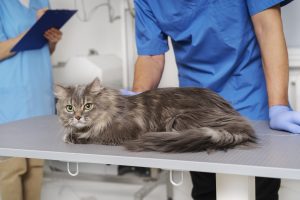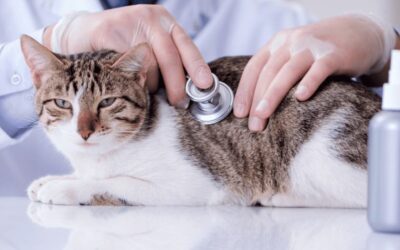Cat UTI Causes, Symptoms, Diagnosis & Treatment [Guide]

Cats are beloved companions who are often regarded as family members. Like all members of our family, we want them to stay healthy and happy, which means being aware of potential health problems they may face. One such issue is a urinary tract infection, commonly known as a UTI. Understanding cat UTI signs, symptoms, and treatment options is vital for maintaining their well-being.
Understanding the Urinary Tract in Cats
The feline urinary tract comprises the kidneys, ureters, bladder, and urethra. Its primary function is eliminating waste and regulating the body’s fluid balance. In a healthy cat, urine is produced in the kidneys, travels through the ureters to the bladder, and is expelled through the urethra during urination. When the urinary tract becomes infected, it can lead to a UTI.
Common Causes of Cat UTIs
Several factors can contribute to the development of a UTI in cats. One of the most common causes is bacteria entering the urinary tract. This can occur when bacteria from the environment, such as litter boxes or dirty surfaces, find their way into the urethra. Female cats are more prone to UTIs due to their shorter urethra, which allows bacteria to travel to the bladder more easily. Other causes include bladder stones, tumors, or underlying medical conditions that compromise the immune system.
Signs and Symptoms of a Cat UTI
Recognizing the signs and symptoms of a cat UTI is vital for early intervention. Even though cats can’t vocalize their discomfort, they often display specific behaviors signaling a potential UTI. These may include frequent urination, straining during urination, blood in the urine, or urinating outside the litter box. Additionally, cats with UTIs may exhibit signs of discomfort, like excessive licking of the genital area or vocalization while urinating.
Furthermore, certain litter types on the market, such as those with monitoring crystals like Purina Tidy Care, can aid in early detection by indicating changes in your cat’s urine or urinary patterns. If you notice any unusual signs, it’s essential to promptly consult your vet for further evaluation and treatment.
Diagnosing a Cat UTI
If you suspect your cat has a UTI, it’s essential to consult a veterinarian for a proper diagnosis. The veterinarian will perform a thorough physical examination and may request a urine sample for analysis. Blood tests or imaging studies may sometimes be necessary to rule out other underlying causes. The urine sample will be examined for bacteria, red or white blood cells, and crystals. A definitive diagnosis will allow the veterinarian to prescribe the most appropriate treatment for your cat.
Treatment Options for Cat UTIs
Treating a cat UTI typically involves a combination of medication and supportive care. Antibiotics are commonly prescribed to eliminate bacterial infections. The specific antibiotic and duration of treatment will depend on the severity of the infection and the cat’s overall health. Pain medication may also be prescribed to alleviate discomfort during urination. In addition to medication, it’s crucial to ensure your cat stays hydrated and has access to clean litter boxes. Providing a stress-free environment and maintaining proper hygiene can also aid in the recovery process.

Home Remedies for Cat UTIs
While home remedies may provide temporary relief, they should never replace veterinary care for a cat UTI. However, you can take a few steps at home to support your cat’s recovery. One popular home remedy for cat UTIs is increasing water intake. Cats are notorious for not drinking enough water, which can contribute to urinary issues. By providing fresh water in multiple locations throughout the house and even investing in a cat water fountain, you can encourage your feline friend to drink more water and promote urinary health.
Another effective home remedy for cat UTIs is the use of cranberry supplements. Cranberries contain compounds that can help prevent bacteria from adhering to the urinary tract, reducing the risk of infection. It’s important to consult with a veterinarian before starting any supplements to ensure they are safe for your cat and won’t interfere with any other medications they may be taking.
Additionally, incorporating a high-quality, grain-free wet food into your cat’s diet can help promote urinary health. Wet food has a higher water content than dry kibble, which can help flush out the urinary tract and prevent the formation of crystals or stones.
Tips for Administering Home Remedies to Cats
Administering home remedies to cats can sometimes be a challenge, as they can be finicky and resistant to change. However, with a few tips and tricks, you can make the process smoother for both you and your furry friend.
Firstly, it’s important to start slow and gradually introduce any changes to your cat’s routine. For example, if you’re switching to a new wet food or introducing cranberry supplements, mix it in with their current food and gradually increase the amount over time. This will help your cat adjust to the new taste and texture without causing digestive upset.
Another tip is to make the administration of home remedies a positive experience for your cat. Use treats, praise, or playtime as rewards for cooperating during the process. This will help create a positive association and make future administrations easier.
Lastly, be patient and observant. Cats can be creatures of habit, so it may take some time for them to fully accept the changes to their routine. Keep an eye out for any adverse reactions or changes in behavior, and consult with your veterinarian if needed.
Complications and Untreated UTIs
If left untreated, cat UTIs can lead to serious complications. The infection can spread to the kidneys, resulting in a more severe condition known as pyelonephritis. This can cause kidney damage and potentially be life-threatening. Additionally, chronic UTIs can lead to bladder stones or blockages, which require further medical intervention. It’s crucial to seek veterinary care promptly if you suspect your cat has a UTI to prevent these complications from arising.
Preventing Cat UTIs
Prevention is key when it comes to cat UTIs. You can take several measures to reduce the risk of your cat developing a UTI. Clean, fresh water always encourages proper hydration and helps flush out your cat’s urinary tract. Regularly cleaning and maintaining litter boxes ensures a clean environment for your cat to eliminate waste.
Moreover, offering a well-rounded diet that supports urinary health can play a significant role in warding off UTIs. For instance, incorporating wet food rich in moisture content can promote hydration and urinary tract function, reducing the likelihood of infections. Additionally, creating a serene and secure environment for your cat, perhaps with cozy hiding spots or soothing background music, can effectively minimize stress and support their overall well-being.
When to See a Veterinarian
If you suspect your cat has a UTI or notice any signs and symptoms mentioned earlier, it’s crucial to seek veterinary care promptly. Your veterinarian will be able to provide an accurate diagnosis and recommend the most appropriate treatment plan. Delaying veterinary intervention can lead to complications and prolong your cat’s discomfort. Remember, as a responsible and loving cat owner, you must prioritize your cat’s health and seek professional help.

How Can Pet Insurance Help You if Your Cat Has A UTI?
Pet insurance can be a valuable tool in managing the costs of treating a cat’s urinary tract infections and other veterinary expenses. By having a pet insurance policy in place, you can have peace of mind knowing that you can provide medical care for your furry companion without worrying about the financial burden. Pet insurance can help cover the costs of veterinary consultations, diagnostic tests, medications, and even specialized treatments if required.
Reimbursement
This method is the most common for pet insurance companies. You pay out of pocket for the veterinarian bill, and then the insurance company reimburses you for what’s covered under the insurance plan. The steps look like this.
- You pay the vet bill after your cat’s visit.
- You fill out the pet insurance claim form.
- Submit the claim form and other required documentation to the insurer.
- After the claim is approved, you will be reimbursed for eligible expenses.
What Does Odie Pet Insurance Cover?
Pet insurance covers various veterinary expenses, providing financial protection and peace of mind for pet owners. Here are the details of the coverage options offered by Odie Pet Insurance:
Illness & Injury Plan
The Illness & Injury Plan is an all-inclusive insurance plan designed to cover a wide range of medical needs for your pet. This plan includes comprehensive coverage for various illnesses, injuries, and veterinary services. Some of the covered items include:
- Veterinary exams and consultations
- Diagnostics (e.g., X-rays, lab tests)
- Prescribed medications
- Surgeries and hospitalization
- Rehabilitation, acupuncture, or chiropractic treatments
- Medically necessary supplies
- Euthanasia and cremation
The Wellness Plan
The Wellness Plan is a monthly membership that focuses on preventive care and covers routine veterinary services.
- Provides reimbursements for routine care items such as wellness visits (exams and vaccines), testing and parasite prevention, dental cleanings and at-home dental care, vitamins, supplements, and more
- Through Odie’s partnership with Petivity, a leader in smart pet products and proactive care, Wellness Plan members can also receive reimbursements for Petivity devices and health kits, as well as eligible Purina food and supplements.
- Total reimbursement up to $700 per year.



